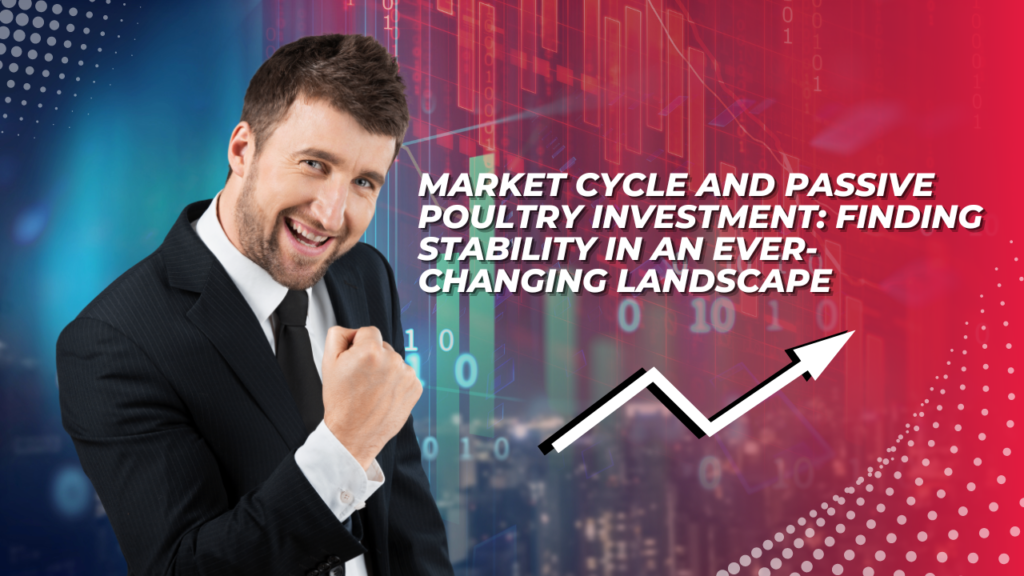- Bizquick Estates & Overseas Pvt Ltd
- +1-725-207-3489
- +91-774-508-5581

Investing in any sector requires an understanding of market cycles, and the poultry industry is no exception. For those exploring passive investment options, poultry farming offers a unique blend of stability and growth potential—especially for investors who grasp the cyclical nature of this market.
In this post, we’ll delve into the relationship between market cycles and passive poultry investment, showing how savvy investors can find long-term stability in an ever-changing economic landscape.
A market cycle is the natural rise and fall of economic activity, typically defined by four stages: expansion, peak, contraction, and recovery. Every industry, including poultry farming, is influenced by these cycles.
Expansion: During this phase, demand for poultry products grows. Increased consumer purchasing power, higher consumption of meat products, and rising exports are key drivers.
Peak: As the market reaches its peak, supply matches or slightly surpasses demand, often leading to stabilization in poultry prices.
Contraction: The market contracts when supply outstrips demand, often leading to lower poultry prices and reduced profit margins for farmers and investors.
Recovery: As the economy improves, so does the demand for poultry products, leading to a new cycle of expansion.
By understanding where the poultry industry stands in the market cycle, investors can make informed decisions about when to enter, hold, or exit their investments.
Poultry farming, especially as a passive investment, offers a relatively recession-resistant option compared to other agricultural sectors. Here’s why:
Constant Demand: Poultry is a staple protein source across the globe, with growing demand due to population increases, changing dietary preferences, and urbanization.
Short Production Cycle: Compared to cattle or pork, poultry (especially chickens) have a shorter production cycle, allowing for quicker returns on investment.
Low Market Entry Barriers: Poultry farming has fewer complexities in terms of operational costs, making it accessible for investors who want to engage in passive investment through partnerships with farmers or managed services.
Diversification Opportunity: For investors looking to hedge their portfolios, poultry provides a way to diversify beyond traditional stocks and bonds, potentially stabilizing returns during periods of market volatility.
Timing is everything when it comes to investing. For those in passive poultry investment, understanding market cycles can help avoid losses and maximize gains.
During Expansion: This is a prime opportunity for investors to expand or enter into poultry farming. With rising demand and prices, the return on investment is often higher. During this phase, partnerships with poultry farmers can yield strong, consistent income.
At Peak: While the peak represents stability, it is essential to monitor the market for signs of oversupply. Investors can enjoy steady profits but should remain cautious about potential shifts toward contraction.
In Contraction: While profits might shrink during a contraction, it can also be an ideal time to enter the market. Lower asset prices and reduced competition create opportunities for investors to acquire or expand their poultry operations at a discount.
During Recovery: As the market recovers, so does profitability. Those who invested during contraction benefit the most from the surge in demand. This is also a great time for new investors to jump in, as poultry markets begin a new phase of expansion.
For investors seeking passive income from poultry, aligning with the right operational partners and leveraging technological advancements is key. Here are a few strategies:
Collaborative Farming: Partnering with experienced farmers or companies that offer managed poultry farming services allows investors to earn without dealing with day-to-day operations. This model has become increasingly popular, especially with the rise of agricultural investment platforms.
Sustainability and Innovation: With consumers growing more conscious of sustainability, investing in organic or free-range poultry farms can provide a niche advantage. Additionally, adopting innovative farming technologies, such as automated feeders and climate-controlled coops, can increase efficiency and returns.
Diversifying Poultry Products: Beyond meat, the demand for eggs and processed poultry products presents a way to diversify income streams within the poultry sector.
Though market cycles present challenges, they also offer opportunities—especially for passive investors in the poultry industry. By understanding where the market stands and aligning investments accordingly, it’s possible to find stability in an ever-changing landscape. With the right strategies, poultry farming can provide a consistent and potentially lucrative passive income stream for both seasoned and new investors alike.
Passive poultry investment allows individuals to navigate market cycles confidently, yielding profits and long-term growth through well-timed decisions and strategic partnerships.
Bizquick Estates & Overseas Pvt Ltd
Bizquick aims to be one of the leaders in managed business. Bizquick develops, produces, manages, harvests, processes and markets the products by covering the entire process.
Passive Income
Your path to passive income for lifetime starts with Bizquick